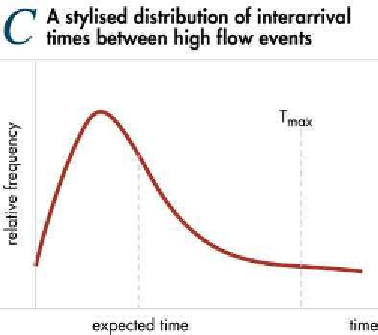Agriculture Reference
In-Depth Information
strategy may be to fill the billabongs and lagoons at the start of the cycle, allow the river
to drop and then flush the billabongs at the end of the cycle. This is consistent with a
point made by Hillman et al. (2003) that the connection sequence is more important than
the duration of the event. Nevertheless, the duration of the event is kept as the focus here
for simplicity.
The objective here is not to design the specific features of a high flow event but to
establish the concepts that underlie an environmental release strategy. The key point is
that a prerequisite to the implementation of a planning framework is a well defined link
between alternative hydrological flow regimes and community preferences for different
environmental outcomes.
The frequency of occurrence of the event is central to the development of a release
strategy. The frequency of occurrence of an event can be characterised by the distribution
of return or interarrival times between events, a concept that is well established in
queuing theory. A stylised distribution showing the relative frequency of the duration
between events is shown in Figure C. The figure shows key aspects of the distribution
that may have an impact on the underlying environmental objectives. These include the
expected time between events and the likelihood that the time between events will exceed
a critical threshold, Tmax. The relative importance of these or other distributional
parameters is subject to debate. However, the parameters are not independent, and a flow
regime designed to affect one will affect the other.
For illustrative purposes, the focus again is on the likelihood that the time between
events will exceed the critical threshold, Tmax. A desired change in the inter-arrival time
distribution is shown in Figure D, with a reduction in the probability that the time
between events will exceed Tmax. That is, the area under the curve that exceeds Tmax is
reduced. This reduction can be interpreted as an increased reliability, or probability, that a
release strategy will achieve the targeted outcome of a high flow event occurring within
the specified time frame.


Search WWH ::

Custom Search